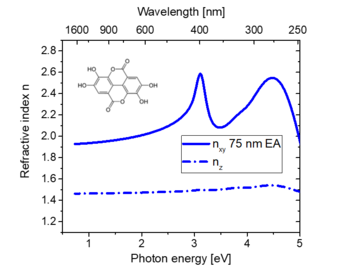Thin film analysis for organic electronics
Spectroscopic ellipsometry
We analyze the uniaxial optical dispersion of semi-conducting organic thin films by standard spectroscopic ellipsometry in the wavelength range of 245 nm to 1700 nm. Hereby, we utilize interference enhanced substrates of 500 - 1000 µm SiO2 to optimize the sensitivity of the method for a selected wavelength range.

Optical modeling using harmonic oscillators, effective medium approximations, or Bspline functions are applied to derive the following layer parameters:
- thickness and roughness
- uniaxial optical dispersion: refractive index n(λ) and extinction coefficient k(λ) or ε1,ε2(Eph)
- energy of electronic transitions and gap energy
- birefringence Δn(λ)
- order parameter S2
- blend composition
Grazing incidence X-ray diffraction (GIWAXS)
We identify lattice planes, crystalline texture and the average orientation distribution of crystallites by 2D-GIWAXS in vacuum.
Raw GIWAXS images are corrected for the use of a planar detector. Asuming isotropy of the crystallites in the xy-plane the negative qxy direction is mapped to the positive direction to remove the blind areas of the detector from the image. Radial or azimuthal sections are performed to evaluate reflection maxima I(q) as well as the FWHM of the crystallites orientation distribution I(χ). All data analysis is carried out with self-written Phython scripts.

Bittrich, E. ; Domke, J. ; Jehnichen, D. ; Bittrich, L. ; Malanin, M. ; Janke, A. ; Uhlmann, P. ; Eichhorn, K.-J. ; Papamichail, A. ; Stanishev, V. ; Darakchieva, V. ; Al-Hussein, M. ; Levichkova, M. ; Fritz, T. ; Walzer, K. Morphology of thin films of aromatic ellagic acid and its hydrogen bonding interactions J. Phys. Chem. C 124 (2020) 16381-16390.
X-ray reflectometry (XRR)
For the analysis of the critical angle of total external X-ray reflection (TER) we apply XRR (Cu Kα). The reflectivity curve is modeled with the software REFLEX (Vignaud, G.; Gibaud, A. J. Appl. Cryst. (2019), 52, 201-213) to obtain the thickness and roughness of a thin film (or a layer stack) as well as the energy specific critical angle θc of TER. From θc the mass density of the film material is calculated.

Mid-IR-spectroscopy of ultra-thin films
We use infrared reflection absorption spectroscopy (IRRAS) and ATR-FTIR with ATR Si-wafer unit to analyze molecular vibrations in nm-thin films. Hereby, we focus on vibrations involved in H-bonding interactions and characterize the stability of H-bondings with temperature.
Normalized ATR-FTIR spectrum of 10 nm ellagic acid (EA) on Si-wafer. The crystal lattice of EA is stabilized by H-bonding.

